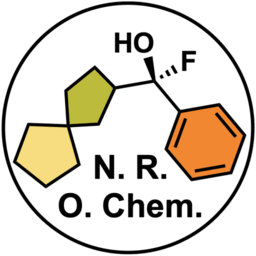Synthesis of Lasmiditan
Lasmiditan is an orally bioavailable selective serotonin receptor agonist discovered by Eli Lilly and Company and approved by the FDA for the acute treatment of migraine in adults. In this blog post, I am going to talk about the chemical synthesis of this drug, while reviewing some interesting strategies medicinal chemists use in their labs to successfully accomplish the synthesis of their targeted molecules.
Retrosynthetic Analysis
A robust synthesis of the drug was described by researchers at Eli Lilly. From a retrosynthesis point of view, a good disconnection would involve breaking the highlighted carbon-nitrogen bond, which could be forged via amide coupling between an acid chloride and an amine. The amine fragment could be prepared by the reaction between a Grignard reagent and a Weinreb amide.
Synthesis steps
The synthesis begins with the formation of the acid chloride by treating this commercial carboxylic acid with thionyl chloride. Conversion of the acid chloride to the corresponding Weinreb amide was achieved in the presence of dimethylhydroxylamine and triethylamine in DCM at 0 to 5 ºC. Subsequent treatment of the Weinreb amide with the organolithium reagent, which was generated in situ by the reaction between 2-chloropyridine and n-BuLi, delivered the desired ketone.
It is interesting to note here the conditions adopted by the authors in order to favor the alpha lithiation even in the presence of an ortho directing group. On the other hand, competition between hydrogen-metal exchange and halogen-metal exchange was not an issue, because halogen-metal exchange of a chloropyridine is not highly favored. If the halogen had been iodine or bromine instead, this reaction could have been very rapid, depending on the conditions employed.
The addition of dimethylaminoethanol into a solution of butyllithium in hexane at -78 ºC generates a superbase. This combination, in addition to the strongly basic effect, shows unusual and interesting characteristics in the deprotonation of common heterocyclic systems, allowing the functionalization of the 6-position in 2-substituted pyridines, giving way to the direct synthesis of otherwise difficult-to-prepare compounds.
Note: you may find more information about this unimetal superbase for deprotonation of aromatic heterocycles in the following links: (1) Butyllithium–Lithium Dimethylaminoethanol. (2) J. Org. Chem. 2002, 67, 234.
The Weinreb amide is also necessary to deliver the desired ketone, since a Grignard reaction on the acid chloride would deliver a tertiary alcohol, and this is because the intermediate ketone is still highly reactive towards the organometallic reagent. In this transformation, however, the partial negative charge on the carbon in the R group attacks the electrophilic carbonyl carbon pushing electron density onto the oxygen atom. The metal ion chelates then between the carbonyl oxygen and the methoxy oxygen. And since this tetrahedral intermediate doesn’t collapse until acidic aqueous workup no over-addition occurs.
The next step was a Buchwald−Hartwig reaction employing benzophenone imine followed by acidic deprotection to provide the primary aryl amine in 82% yield over two steps. This two-step transformation is of special interest to medicinal chemists because it allows the facile conversion of a 2-chloropyridine to the corresponding 2-aminopyridine. Basically, it allows you to swap a chlorine atom with a nitrogen atom at the alpha position of the pyridine.
Finally, amidation with this benzoyl chloride followed by subjection to succinic acid furnished lasmiditan as the hemisuccinate salt in excellent yield over two steps.
Reference work:








